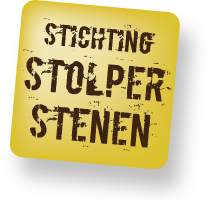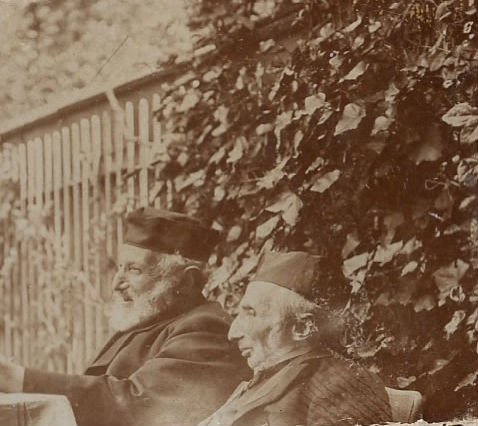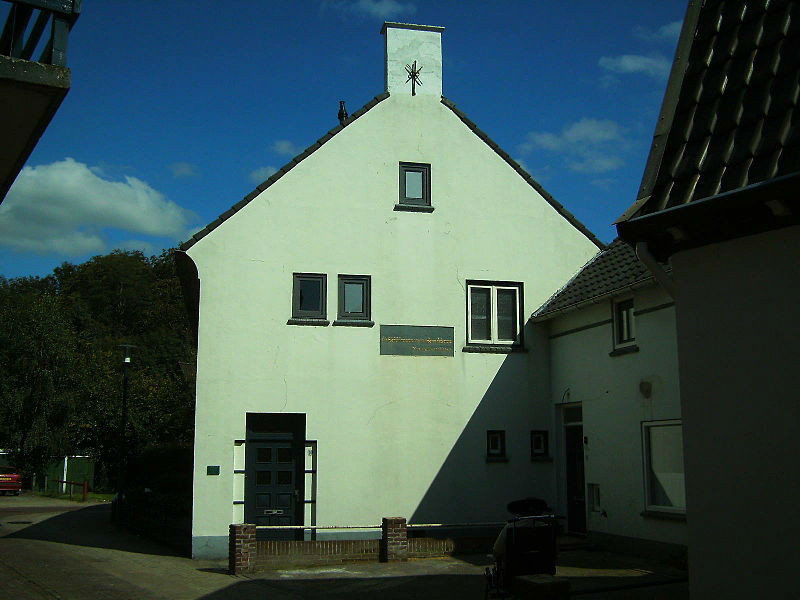
It seems that in 1285 a Jew named Salomon de Grolo (Groyle) Vromuit possessed land in Groenlo. He was married to Jutta, the daughter of Samuel Halevi. They had children and it is possible that they lived in Groenlo for 25 years. Their names appear in a register from Koln from the year 1285.Only during the second half of the 17th century were Jewish families were allowed to settle in Groenlo.
The Jews of Groenlo
According to a deed from 1686 the mayor, the deputy mayor and council members, issued a charter for a pawn shop to Levi van Bingen and his son David ben Levi van Bingen. It appears however that consent had already been given twelve years earlier, and that the shop existed already since 1674. The deed was issued "since no complaint about these Jews, has been received by us."
The aforementioned Jews were allowed to remain in Groenlo and to carry out their money business and to pawn used garments and second hand objects. On pawns of less than 15 guilders they were allowed to charge five cents "registration money", and for higher amounts, a farthing per half-a-crown.
Between 1819 and 1825 sales of non-redeemed pawns were held. In 1820 such a sale yielded the amount of 180 guilders; usually such sales yielded about 100 guilders.
It is interesting to note that the lady who owned the Lombard could not write. Probably this was done by her nephew or by a niece who lived with her. According to her testament her nephew and niece would each inherit the amount of 1,200 guilders, which was a sizeable amount at the time.
The pawn shop remained in Jewish hands till 31 December 1895, when it was closed by law. The last holder was David Israel Heymans, who became a grocer after closure, and later on a wholesale trader in yarn, ribbon, and "Grolse mittens."
From 1897 his heirs managed a polishing-cotton factory, which existed till after the end of the Second World War. The production process was based on cotton waste.
Means of living
It is difficult to state the exact number of Jews in Groenlo at the start of the 19th century. We know the Mendels family, which was probably the oldest family which lived there from 1741 till today. There is no mentioning of their profession. Later on there were the Heymans brothers. One of them was known as a horse veterinarian. Their sons, Salomon and Meyer Heymans were shopkeepers and butchers. This family also owned a sausage factory and traded in cattle and pigs.
During the great crisis Chief Rabbi Vredenburg gave special consent to produce "cheap" canned meat for the "Crisis Cattle Center" in The Hague. Rabbi Vredenburg arranged the "Shochtiem," the "Porshiem," Rabbinical supervision and even covers with the Hebrew "Kosher."
There was a Jewish bookshop, a liquor store and a lottery seller.
The reserve car of the local fire brigade was nicknamed "Joddenspuitje" – the Jewish nozzle. It was a small installation which was always the last to reach the fire, pushed by loudly shouting and gesticulating Jews. They always were the last ones to reach the fire, because "the fire had first to be very high."
About 1813 Groenlo counted about 40 Jews, including one Portuguese Jewish family. Following the Napoleonic law from 1812 family names were adopted: Heymans, Gans, Kok, Gomperts, Urbach and Ricardo.
The synagogues
Till 1809 Groenlo had a home synagogue. When the Jewish community of Groenlo heard that King Ludwig Napoleon planned a visit to the town in March, they decided to write him a letter.
After the necessary titles they described the bad situation of the home synagogue, followed by a request of assistance: "as befitting a Church in which we may practice our religion."Possibly their request was granted.
In his Biographical Dictionary from 1843 van der AA mentions: "The synagogue is housed in a separate building, erected during the reign of King Lodewijk Napoleon, with a mild contribution of this King."
The new synagogue was inaugurated only in 1822. Not everybody was content with the new House of God, and some tried to disturb the prayers. According to a Jewish letter of protest from 1823, a certain farmer, by the name of Slotboom, used to clean his stable on Saturday. He always scattered the manure on the path leading to the synagogue, or put his manure cart on a spot which obstructed the path. The town of Groenlo probably reprimanded this farmer.
In 1872 the 50th anniversary of the synagogue was happily celebrated. Accompanied by music the community went to the new synagogue. In the evening there was dancing. In 1892 the 70th year was celebrated and in 1912 the 90th year of its existence. Some pictures of this occasion have been saved, showing the Chief Rabbi L. Wagenaar, the cantor D. Fortuin and the synagogue wardens D.J. Heymans, B. Heymans, H.H. Heymans,
J. Mendels and L. Trijbits.
 |
| De broers David Israël Heimans (1837 - 1918) en Jacob Israël Heimans (1831 - 1910). |
In 1922 the synagogue existed 100 years, which also was an opportunity for a great celebration. Services continued, till, during the war, the Germans made this impossible.
The silver ornaments, the Torah scrolls and the copper candle holders, were hidden during the war by J.M. Heijmans and were all recovered undamaged. After the war the synagogue building was renovated and services continued until 1949, when the community was abolished. In 1959 the former synagogue wardens were authorized to sell the building.
A stone tablet from the synagogue, with the Hebrew inscription: "How good are your tents, O Jacob, your tabernacles, Israel" (Numeri, chapter 24, v. 5), has been relocated to the facade of the former Synagogue.
 |
| The stone tablet relocated in the middle of the facade of the former Synagogue. |
Jewish education
In 1813, when the synagogue of Groenlo had not yet been built, the
Jewish children received Jewish lessons at home. After completion of the synagogue building, a schoolroom and a meeting hall were added in 1822.In 1840 a Jewish school was founded for approximately 30 pupils, aged six till thirteen.
There aren't many details on this period; a teacher is mentioned in 1853. The next teacher functioned also as a cantor and shochet. Most teachers stayed for one or two years only, but in 1873 Levy Schweiger arrived, who stayed till 1898.
In 1865 a new school building was inaugurated. In 1903 David Fortuin arrived, who taught the children for 40 years, and became an integral part of the community. He and his wife Betty were deported and murdered by the Germans.
There was a school committee, supervising the teaching. Schooling fees had to be paid; children from poor families were exempt from payment.
Much was demanded from a Jewish teacher. He had to be of Dutch origin and a member of the Israelitische Kerkgemeenschap, he had to show proof of proper moral and religious conduct and to be a qualified religion teacher. He also functioned as the cantor and was required to have good knowledge and correct pronunciation of the Hebrew language. Furthermore experience in the Torah reading with the song characters(laajnen) was required. Often the teacher was also the shochet and a member of the consistory.
According to Dr. Heymans, Jewish lessons were given each day for one hour and on Sunday mornings for two hours. On Shabbat morning the children had to join the "chewre," a group of "learning."
The Jewish youngsters went to high school in Winterswijk, which took into account the early start of the Shabbat in winter, and allowed the pupils to leave Friday one hour earlier. On Shabbat the school was closed.
After the war no regular Jewish lesson were given anymore in Groenlo.
The cemetery
In 1838 the Jewish community of Groenlo addressed the mayor requesting to safeguard the graves of the Jewish cemetery, which were sometimes vandalized, and furthermore to allocate a new cemetery. The
Gedeputeerde Staten of Gelderland decided to safeguard the graves as requested and authorized the establishment of a new graveyard outside the Beltrumerpoort. The Jewish community did not accept the proposed location.
Several letters prove that the old cemetery was located at the foot of the town walls, which were sometimes damaged during burials.
In 1845 a new petition for another graveyard was not well received.
We do not know where the old graveyard was located. In 1876 the town council of Groenlo gave the Jewish community a parcel of land in long-lease tenure, also outside the town walls, north and northeast from the town, along the town canal. Obviously this was near the Mussenwerk-bolwerk, or the Kanonswal, between the Notenbomen Street and the canal.
It was forbidden to damage the roots of the nearby oak trees when digging a grave. The lease was for 99 years, against payment of four guilders a year, from 1 November 1845 till 1 November 1944.
In 1853 an application to enlarge the cemetery was filed, which was approved in 1857. In 1873 a wall was erected around the graveyard, and restored in 1976.
In 1896 the cemetery was sold to the Jewish community. The cemetery had then fifty graves. After the war the graveyard was restored by the municipality of Groenlo, and several more burials took place. Today there are 55 graves.
There was a second cemetery, used till 1909, where Jews from Groenlo were buried, situated on the Kerkdijk in Vragenender near Lichtenvoorde.
The most common name in the graveyard is Heijmans. The Jewish community of Groenlo was indeed nicknamed the "Heijmanskille." Other names on the tomb stones are: Mendels, Mogendorff, Frankenhuis and Trijbits. The Groenlo cemetery has been declared a state monument.
Troubles
Sometimes the inhabitants of the villages, and from time to time also town people, were plagued by beggars and thieves. Jews or gypsies were often accused of such deeds. In most cases however, it turned out that the culprits belonged to the regular population, and almost never to the aforementioned groups.
Nevertheless the town decreed in 1733 that Jews, peddlers and trades people were not allowed to stay at night without a special permit. In 1750 came the order that non-resident Jews were not allowed to trade in Groenlo, followed in 1752 by another decree that all Jews carrying a pack were to be frisked.
Jews were regularly accused of stealing and arson. That also happened to Meyer Heymans, who was suspected in 1862 of arson, and who was incarcerated together with his wife. Finally the real culprit was found and Heymans and his wife were released. In the meantime however his business had been ruined. Thanks to an appeal published in the Nieuw Israelitisch Weekblad of 1869, funds were raised enabling the family Heymans to start again.
Regulations
In December 1905 regulations were composed and signed by the consistory and church wardens. The 235 articles, divided in ten chapters, dealt with income, expenses, institutions of the community and charity.
Societies
There were three societies in Groenlo. Talmud Touro Gemilus Hasodiem, the members of which were saying prayers with ill or dying people and with mourners. This society also held prayer meetings in the school room.
There was also a woman association, about which there is no information.
The Alliance Israelite Universelle, aiming at elevating the Jewish population intellectually, socially and politically, had a branch in Groenlo.
The Jewish population of Groenlo
Year Jewish population
1809 - 51
1840 - 116
1869 - 132
1899 - 123
1930 - 105
1945 - 22
Sources:
S. Laansma, De Joodse gemeente te Borculo
(Borculo, Eibergen, Groenlo, Lochem, Neede, Ruurlo).
H. Kooger, Het oude Volk-Kroniek van Joods leven in de Achterhoek, Liemers en het grensgebied.
Extracted from sources:-Yael Benlev-de Jong
Translated from Dutch:-Mechel Jamenfeld
Editing:-Ben Noach
Final editing:-Hanneke Noach